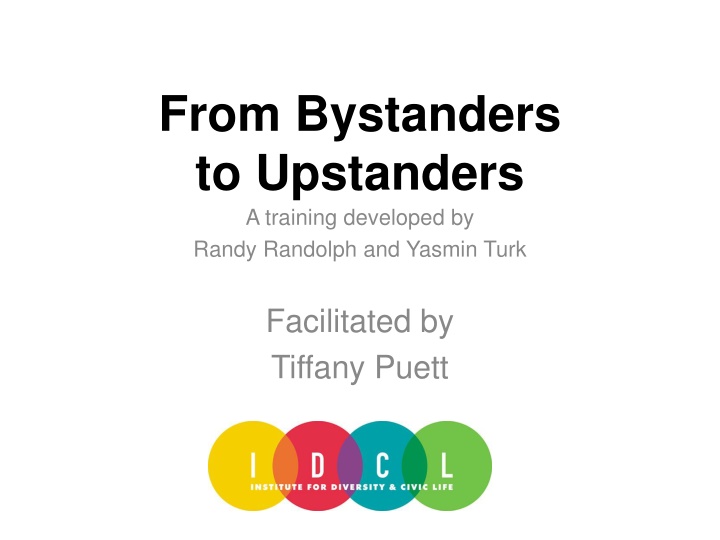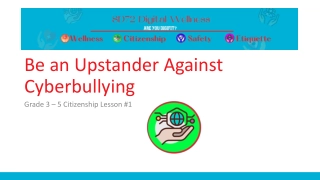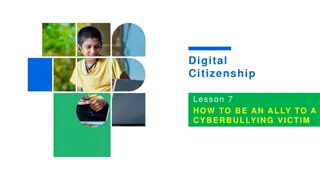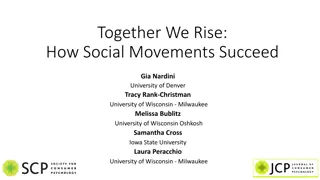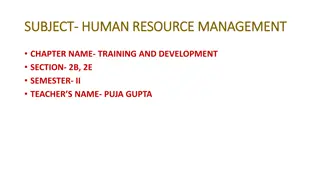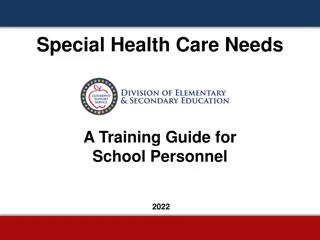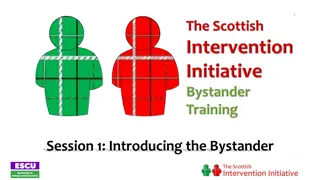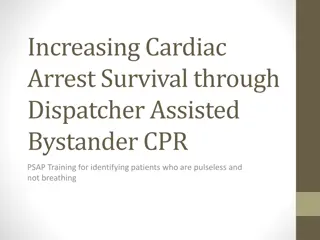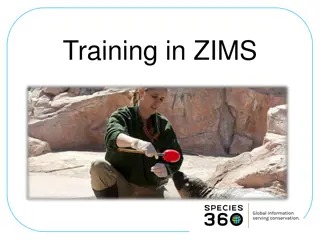From Bystanders to Upstanders Training Guide
Training materials developed by Randy Randolph and Yasmin Turk, facilitated by Tiffany Puett, provide guidelines for safe and productive conversations, steps to become an upstander, and definitions of terms like violence, target, aggressor, bystander, and upstander. The materials emphasize self-talk, focusing on the target, de-escalation, engaging the crowd, and ongoing support for the target. Overcoming obstacles like the bystander effect is discussed, offering insights into why people may hesitate to take action in certain situations.
Download Presentation

Please find below an Image/Link to download the presentation.
The content on the website is provided AS IS for your information and personal use only. It may not be sold, licensed, or shared on other websites without obtaining consent from the author.If you encounter any issues during the download, it is possible that the publisher has removed the file from their server.
You are allowed to download the files provided on this website for personal or commercial use, subject to the condition that they are used lawfully. All files are the property of their respective owners.
The content on the website is provided AS IS for your information and personal use only. It may not be sold, licensed, or shared on other websites without obtaining consent from the author.
E N D
Presentation Transcript
From Bystanders to Upstanders A training developed by Randy Randolph and Yasmin Turk Facilitated by Tiffany Puett
Guidelines for safe, productive conversations speak from our own experience and not for others actively listen to each other and not interrupt identify and explain our responses to trigger words. use feedback (as in when you said ... I felt ) maintain confidentiality for what is said here agree that we can make mistakes and that we are all here to learn acknowledge and respect the fact that we each bring different experience, awareness and knowledge to this topic Institute for Diversity & Civic Life, 2015
Six Steps to Becoming an Upstander 1. Self -talk yourself into action 2. Focus on the target and avoid the aggressor 3. Use body language and positioning to shift the power dynamic 4. Deescalate through tone and volume 5. Engage the crowd in helping 6. Continue to support the target
Defining terms Violence: Violence is anything that denies human integrity, and leads to hopelessness and helplessness. Dr. Martin Luther King, Jr. Target: the person who is being targeted by violence or aggression Aggressor: the person who is saying or doing something aggressive toward another person
Defining terms Bystander: a person who is present when someone is in trouble but does not take action. Upstander: an individual who takes action when they see someone in distress by interrupting the violence, confronting the aggressor, getting help, reporting it to the authorities or helping the target
THE 6 STEPS TO BECOMING AN UPSTANDER EXPLAINED
Step #1: Self-talk yourself into action Our self-talk can either motivate us into taking helpful actions or paralyze us. To prevent us from inaction and move us toward helping behavior, we have to examine this self-talk and change it.
Obstacle #1: The Bystander Effect The phenomenon of people standing by when something is happening that requires action Causes: Ambiguity: witnesses are unsure whether events are serious enough to warrant intervention Diffusion of responsibility: we assume that someone else will intervene/call for help or it's someone else's job to intervene Fear of social disapproval: we tend to depend on others for social cues and can feel socially awkward about getting involved when no one else is intervening
Obstacle #2: Self-doubt and self- talk that leads to inaction Thoughts of self-doubt: I don t want to get involved. I don t know the whole story. Someone else will do something. Instead of doubting ourselves, we need to commit to two simple things: 1. There is a person in distress that needs my help. 2. Offering help is always the right thing to do.
Step #2: Focus on the target and ignore the aggressor While it may seem counterintuitive, it is safer and feels more comfortable regardless of your personality type. When someone feels publicly humiliated and no one helps, they feel cast out from the crowd. Therefore, feeling included rather than excluded from the community helps give them back what the aggressor took away from them.
As we move into action, it is important that we keep the following in mind: Targets of aggression are often unable to come to their own defense. Ideally, they would look directly at a particular individual and say, I need your help. Since this is unlikely to happen, we must be prepared to offer unsolicited help. Actions speak louder than words. The actions we take toward helping the target are far more effective than the words we might choose to say if we were planning to take on the aggressor. Distraction is safer than confrontation. In fact, ignoring the aggressor completely and focusing on the needs of the target is always the safest choice.
Step #3: Use body language and positioning to shift the power dynamic We want to diminish the power of the aggressor by positioning ourselves in a way that decreases their impact on the target. Our actions should be aimed at protecting the target from aggressor. Protection is all about keeping the target safe. We can use body language to change the power dynamic. What does our body language say about our relative confidence and strength? With body language, it is important to convey strength because people will react positively when you intervene. It will make the aggressor take you seriously and the target feel more protected by you.
Step #4: De-escalate through tone and volume The way you speak (words, tone and volume) should be calculated to neutralize or calm the situation. Distraction from what is happening is the most effective tool and can be done by choosing neutral topics to engage the target. Make up something that relates to the environment. Grocery store example: Where did you get that yogurt? Ask them for help with an unrelated topic to provide a distraction. Example: Do you know of a gas station near here? Choose words that hint that you know this person or are affiliated with them in some way. Examples: Don t I know you from my kid s school? It s so nice running into you. We should catch up over coffee.
Step #5: Engage the crowd in helping Energize helpers by asking them to help. It s always easier to step in with back up. And, there s safety in numbers. What if we as bystanders invoke the magic words, Can you help me to others in the crowd? Approach one person in the crowd with an invitation to help. If you ask, Can someone help me?, you re much less likely to have anyone step up. Remember that bystander effect? Approach that person with a specific request and move as if they have already agreed. Once you get that one helper, others will be more likely to join you. Before you approach anyone, take a deep breath to center yourself.
Step #6: Continue to support the target After the intervention Check in with the targeted person: I m sorry that happened to you. Are you okay? If their response is that they re not okay, ask them: What do you need now? Follow the lead of what they need. Focus on helping them feel they are accepted or part of the group/community.
